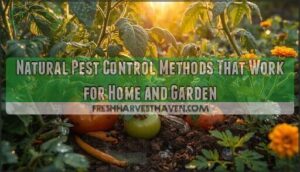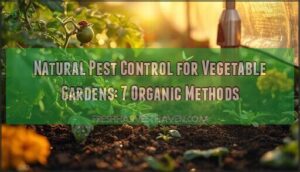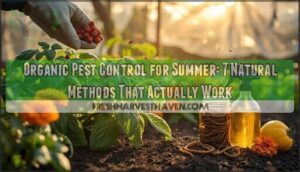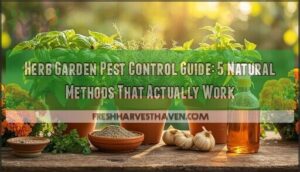This site is supported by our readers. We may earn a commission, at no cost to you, if you purchase through links.
Your tomato plants are under siege, and the usual suspects—aphids, whiteflies, slugs—are winning. You could grab the nearest chemical spray, but there’s a smarter way forward.
Natural pest control methods give you the upper hand without turning your garden into a toxic zone. These approaches work with nature’s rhythms rather than against them, using physical barriers, beneficial predators, and plant-based solutions that target pests while keeping your soil, plants, and family safe.
The best part? They’re often more effective than synthetic options because pests can’t build resistance to a ladybug or a row cover. Whether you’re dealing with indoor invaders or garden destroyers, you’ve got a toolbox of proven strategies that protect what matters most.
Table Of Contents
- Key Takeaways
- Natural Pest Control Basics
- Eco-Friendly Pest Prevention Strategies
- DIY Household Pest Control Remedies
- Physical and Biological Pest Control Methods
- Organic and Chemical-Free Pest Solutions
- Frequently Asked Questions (FAQs)
- What is the best natural pest control method?
- How do you get rid of insect pests naturally?
- How do you keep pests out of your yard?
- What is a good natural pest control?
- What is the holistic approach to pest control?
- How do organic farmers get rid of pests?
- How to fumigate a house naturally?
- How to control pests using natural methods?
- What’s the best natural pest control?
- What does vinegar do for pest control?
- Conclusion
Key Takeaways
- Natural pest control methods use physical barriers, beneficial insects, and plant-based solutions to protect your garden without harsh chemicals.
- Companion planting, healthy soil, and a diverse garden ecosystem work together to prevent pest problems before they start.
- DIY remedies like coffee grounds, vinegar sprays, and essential oils provide effective, budget-friendly ways to manage household and garden pests.
- Organic solutions such as neem oil, diatomaceous earth, and insecticidal soaps tackle serious infestations while keeping your family, pets, and plants safe.
Natural Pest Control Basics
Natural pest control works by targeting pests without harsh chemicals that can harm your garden, your family, or the environment. These methods tap into nature’s own systems—using plants, barriers, and beneficial creatures to keep unwanted visitors in check.
Understanding the basics helps you choose the right approach for your specific pest problems and create a healthier space overall.
How Natural Methods Work
Natural pest control methods work by tapping into nature’s own defense systems rather than fighting against them. You’re fundamentally recruiting allies—beneficial insects, natural predators, and organic solutions—that disrupt pest life cycles without toxic chemicals.
- Biological controls like ladybugs reduce aphid populations by up to 90% within weeks
- Physical barriers interrupt pest egg and larval stages before they mature
- Companion planting releases compounds that naturally repel specific insects
- Integrated pest management combines multiple strategies for ecosystem balance
Effective gardening also involves using natural pest methods to maintain a healthy garden ecosystem.
Benefits for Home and Garden
Understanding how these methods work is one thing—experiencing their benefits firsthand is what makes them truly compelling. Your home and garden become safer spaces when you choose natural pest control methods. Children and pets can play freely without exposure to harsh chemicals, while beneficial insects thrive alongside your plants.
Natural pest control transforms your garden into a safer space where children, pets, and beneficial insects thrive without harsh chemicals
You’ll save money over time, boost your garden’s long-term health, and enjoy peace of mind knowing you’re protecting both your family and the environment through eco-friendly, non-toxic pest management that fosters true garden sustainability.
By adopting eco friendly solutions, you can create a balanced ecosystem that promotes healthy plant growth and minimizes the need for pesticides.
Common Household and Garden Pests
Before you can tackle any pest problem, you need to know what you’re up against. Spiders show up in about 90% of American homes, while flies and ants aren’t far behind at 86% and 80%.
If you’ve spotted cockroaches, mice, or garden destroyers like slugs and aphids, you’re dealing with common pests that natural pest control and organic pest control methods can handle effectively without harsh chemicals.
Eco-Friendly Pest Prevention Strategies
The best defense against pests isn’t what you spray—it’s how you set up your garden from the start. When you build prevention into your growing space, you’re creating an environment where pests struggle to get a foothold.
Here are three foundational strategies that stop problems before they begin.
Companion Planting Techniques
Companion planting pairs crops strategically to create natural pest deterrents right in your garden layout. Think of it as nature’s neighborhood watch—garlic and marigolds planted along borders repel insects, while dill and fennel attract beneficial insects like parasitic wasps.
These plant pairings boost crop diversity and support integrated pest management. Nasturtiums work as trap crops, luring pests away from your prized vegetables without chemicals.
Building Healthy Soil for Resistance
Healthy soil teams up with pest-fighting allies you can’t see. Soil microbes and beneficial insects thrive when you boost organic matter through compost and crop rotation.
This microbial diversity creates soil suppressiveness—your underground defense squad that crowds out harmful pests naturally.
In organic gardening, stronger roots and vibrant plant health start beneath your feet, making natural pest control far more effective than any spray.
Creating a Balanced Garden Ecosystem
A diverse garden ecosystem keeps pests in check naturally. When you increase plant diversity, you attract beneficial insects and pollinators that support ecological balance through plant symbiosis and soil microbiology.
- Mix native plants with crops to draw in ladybugs, lacewings, and birds that feed on aphids and caterpillars
- Add shrubs and ground cover to create shelters where natural predators thrive
- Practice companion planting to confuse pests and boost biodiversity conservation
DIY Household Pest Control Remedies
You don’t need to spend money on expensive chemicals when your kitchen already has what you need to fight pests. Simple ingredients like coffee grounds, vinegar, and essential oils work surprisingly well at keeping unwanted visitors away from your home and garden.
Let’s look at three budget-friendly remedies you can start using today.
Coffee Grounds and Banana Peels
Your kitchen scraps can become powerful DIY pest solutions. Coffee grounds contain caffeine that’s toxic to slugs and snails—studies show they reduce slug populations by up to 90%. Banana peels work differently, offering antimicrobial properties that deter aphids while enriching your soil with potassium and phosphorus.
Together, these eco-friendly solutions provide natural pest control and soil fertilization for healthier organic gardening at home.
Vinegar and Soap Solutions
Mix three parts water with one part white vinegar and add a teaspoon of dish soap—you’ve just created one of the most effective natural pest control methods. This eco-friendly pest control solution targets soft-bodied invaders while staying safe for your family.
Here’s how vinegar spray and soap spray work together:
- The acidic vinegar efficacy disrupts ant trails and deters aphids, whiteflies, and spider mites
- Soap formulations break down protective waxy coatings on insects
- Solution safety remains high for humans and pets when properly diluted
- Spray techniques require reapplication after rain for continued pest resistance
- Vinegar traps double as fruit fly catchers when refreshed daily
Essential Oil Sprays and Herbal Repellents
Essential oil sprays are a powerful tool against garden pests. Cinnamon and clove oils provide protection for over 100 minutes, while petitgrain extends this to nearly 4.5 hours. These herbal extracts deliver real results.
| Essential Oil Blend | Target Pests | Protection Time |
|---|---|---|
| Cinnamon/Clove | Mosquitoes, ticks | 100+ minutes |
| Petitgrain | Mosquitoes | 270 minutes |
| Peppermint/Sage | Multiple species | 300+ minutes |
| Garlic/Lemongrass | Flying insects | 30-60 minutes |
The aromatic compounds in these oils naturally disrupt insect hormones. For effective pest repellent formulas, mix 10-20 drops of essential oil per cup of water.
Physical and Biological Pest Control Methods
Sometimes the best pest control doesn’t come from a bottle—it comes from working smart with barriers, traps, and nature’s own pest fighters. You can physically block pests before they ever reach your plants or invite the good guys who’ll do the dirty work for you.
Here’s how to put these hands-on methods to work in your garden.
Floating Row Covers and Sticky Traps
Sometimes the simplest pest deterrent is just keeping bugs away from your plants in the first place. Floating row covers and sticky traps work as garden barrier methods that physically block or capture pests without chemicals.
Here’s how these crop protection strategies deliver results:
- Row cover materials create a lightweight shield over seedlings, cutting insect populations while allowing sunlight and water through
- Yellow sticky traps capture whiteflies, fungus gnats, and aphids—place one trap per 250 square feet for best results
- Blue sticky trap placement specifically targets thrips while sparing beneficial insects
- Pest monitoring systems give you early warning signs, so you can act before infestations explode
- Garden pest control becomes easier when you combine covers with reflective mulching, reducing whitefly numbers by up to 87%
Research shows floating row covers can boost your profitability by 47% compared to organic sprays, protecting plants during vulnerable growth stages. You’ll need to remove covers when flowering starts to prevent overheating, and watch for weeds underneath since natural predators can’t patrol the area.
These natural pest control methods compete beautifully with conventional options—no mixing, no spraying, just smart barriers doing the work.
Hand-Picking and Physical Removal
When barriers aren’t enough, your own two hands become the tool. Hand-picking pests—those caterpillars, beetles, and aphids lounging on your leaves—works with an 87% success rate in gardens. Drop them into soapy water for quick pest disposal.
This natural pest control method gives you immediate results through physical removal, perfect for pest monitoring when populations are still manageable. Regular crop inspection keeps small problems from becoming infestations.
Attracting Beneficial Insects and Birds
Beyond removing pests yourself, you can recruit nature’s own pest control army. Beneficial insects like ladybugs devour up to 5,000 aphids during development, while birds reduce pest populations by 80% in some farms. Create bird-friendly gardens and insect hotels to strengthen ecosystem balance:
- Plant flowering herbs for natural pest control through companion planting
- Add cover crops attracting beneficial nematodes and microbes
- Include non-crop vegetation for bird attraction
- Practice organic methods supporting pollinator conservation
This approach builds lasting protection.
Organic and Chemical-Free Pest Solutions
Sometimes you need something stronger than coffee grounds and vinegar, but you still don’t want to reach for harsh chemicals. That’s where organic pest solutions come in—they’re powerful enough to tackle serious infestations while keeping your garden safe and healthy.
Here are three proven options that work without compromising your commitment to chemical-free living.
Neem Oil Application
Neem oil is a standout natural pest control solution, effectively managing around 300 insect species without posing harm to your family or pets. Field trials demonstrate an impressive 80-85% pest control efficacy when applied at concentrations of 0.5-2% every 7-14 days. This eco-friendly solution is a reliable choice for those seeking nontoxic methods to protect their gardens.
| Application Method | Best For |
|---|---|
| Foliar spray | Aphids, beetles, caterpillars |
| Soil drench | Root-zone pests, nematodes |
| Early morning application | Maximum absorption |
| Late afternoon timing | Reduced photodegradation |
To apply neem oil, mix it with water according to the label instructions and thoroughly coat both surfaces of the leaves. The oil formulations work by disrupting insects’ hormonal systems, effectively controlling pests while safeguarding beneficial pollinators. Neem extraction yields compounds that act as antifeedants and growth regulators, offering a natural, multi-faceted approach to pest management that enhances the resilience of your garden ecosystem.
Diatomaceous Earth Use
Diatomaceous earth offers another powerful weapon in your natural pest control arsenal. This fine powder works through physical abrasion, scratching insect exoskeletons and causing dehydration rather than chemical toxicity.
You’ll find it particularly effective against ants, bed bugs, cockroaches, and soft-bodied mites. Apply it dry to problem areas like pet beds and garden soil, reapplying after rain to maintain protection.
Horticultural Oils and Insecticidal Soaps
When soft-bodied pests like aphids and mites invade, horticultural oils and insecticidal soaps deliver effective, non-toxic pest control. These eco-friendly pest control solutions offer different pest control spectrums—oils smother insects at all life stages, while soap efficacy targets active nymphs and adults.
Apply horticultural oil types at 2-3% concentration during summer, and insecticidal soap formulations at 1-2% solution. Smart oil application rates matter for protecting beneficial insects.
Frequently Asked Questions (FAQs)
What is the best natural pest control method?
There’s no single “best” method—success depends on your pest. Integrated Pest Management (IPM) combines natural deterrents, organic solutions, and eco-friendly methods.
You’ll get better results mixing sustainable practices than relying on one approach.
How do you get rid of insect pests naturally?
You can eliminate insect pests using organic sprays like neem oil, diatomaceous earth to damage exoskeletons, insect traps, and natural deterrents such as essential oils.
These non-toxic pest control methods disrupt pest life cycles effectively.
How do you keep pests out of your yard?
Keep pests away by installing garden fencing, using eco-friendly traps, and applying natural pest control yard maintenance practices.
Regular inspections paired with wildlife deterrents and insect repellent techniques create effective pest prevention strategies for garden protection.
What is a good natural pest control?
You don’t need harsh chemicals—neem oil, diatomaceous earth, and insecticidal soap stand out as proven natural pest control methods.
These organic solutions disrupt pests without harming your garden’s ecosystem or beneficial insects.
What is the holistic approach to pest control?
Comprehensive pest control combines biological controls, companion planting, and integrated pest management (IPM) to maintain ecosystem balance.
This sustainable approach uses pest ecology principles and eco-friendly practices, reducing chemical dependency while supporting natural predators and biodiversity.
How do organic farmers get rid of pests?
Organic farmers are absolute wizards at pest management, relying on biological control through beneficial insects like ladybugs, companion planting strategies, diatomaceous earth applications, and integrated pest management techniques that champion sustainable farming without harsh chemicals.
How to fumigate a house naturally?
You can fumigate naturally by diffusing essential oils like citronella, peppermint, and eucalyptus throughout your home.
Garlic spray and neem oil also work well as organic fumigation alternatives to toxic chemical treatments.
How to control pests using natural methods?
Controlling critters carefully combines companion planting, beneficial microbes, and eco-friendly traps that work with pest life cycles.
Natural barriers, soil enrichment, and integrated pest management create non-toxic pest control without harsh chemicals.
What’s the best natural pest control?
The best natural pest control combines integrated pest management (IPM) with biological controls like beneficial insects, nontoxic pest control methods such as neem oil, and eco-friendly solutions that disrupt pest life cycles while protecting your garden ecosystem.
What does vinegar do for pest control?
Think of vinegar as a security guard for your home—its acidic properties disrupt ant trails, repel spiders, and deter mosquitoes.
Vinegar spray and traps offer eco-friendly solutions, but frequent reapplication is needed for lasting pest deterrents.
Conclusion
Sooner or later, every gardener faces a new pest challenge. With natural pest control methods, you’re not just defending your plants—you’re building a resilient, thriving ecosystem.
Each choice, from companion planting to inviting beneficial insects, shapes a garden that can stand on its own. As seasons change and new threats emerge, your strategies grow stronger.
The real reward isn’t just healthy tomatoes; it’s the confidence that your garden is safe, sustainable, and truly yours.
- https://farmonaut.com/blogs/5-modern-natural-pest-control-methods-agriculture-2025
- https://ridabuginc.com/blog/the-pros-and-cons-of-eco-friendly-pest-control
- https://ecogenpest.com/are-natural-pest-control-methods-as-effective/
- https://pmc.ncbi.nlm.nih.gov/articles/PMC7914490/
- https://www.deskera.com/blog/benefits-of-natural-pest-control-manufacturing-solutions/










